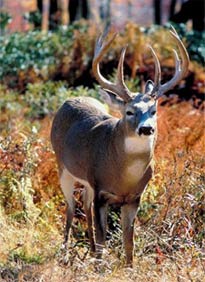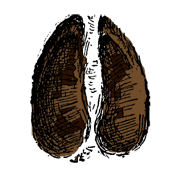Wildlife - Species

Species Specific Regulations
White-tailed Deer
Licenses: Hunting License required and Big Game Permit. WMA Permit is required when hunting on WMA Land.
Limits: Limits vary according to game zones please check Rules and Regulations for Limits.
White-Tailed Deer (Odocoileus virginianus)

White-tailed deer tracks
Description
The white-tailed deer has two seasonal coats. The spring/summer coat is reddish tan, and relatively short, with a thin and wiry hair texture. The winter coat is more grayish or even bluish tan with heavy, long guard hairs and a thick undercoat that provides excellent insulation. White patches are found around the eyes, on the throat, belly, tail (underside), and insides of the legs. When in flight, the large white tail or flag, flipped up in the air can be the easiest way to spot the deer.
Weights vary considerably, but an average adult male weighs 175 pounds while a female weighs about 120 pounds.
Life Expectancy
Approximately 10 years in the wild.
South Carolina State Record: The 1906-2010 SC White-tailed Deer Antler Records are divided into Non-Typical White-tailed and Typical White-Tailed Deer.
Preferred Habitat
Quality deer habitat includes a mixture of trees, shrubs, vines, forbs, grasses and other plants such as fungi and sedges. Certain plants within each of these categories benefit deer more than others. Desirable plants should be well interspersed throughout an area, so that the whole area functions as deer habitat. Some type of water source should be available every mile or so. Enough area with appropriate plants should be available to support a viable population.
Range
Statewide. Deer population by county is not comparable among counties because counties vary in size and are, therefore, not directly comparable.
Food Habits
- White-tailed deer are extremely adaptable in their food habits.
- Deer consume primarily wild herbs, fruits and agricultural crops; however, they can survive on the leaves, buds and twigs of woody trees and shrubs when other foods are scare.
- When abundant, acorns are the mainstay of the fall and winter diet.
Reproduction
Peak Breeding Activity
Map of Peak Breeding Date for White-tailed Deer in South Carolina
Early to mid-November; begins as early as mid-October and runs through mid-January
- Courtship activities among deer begin in mid-October. Bucks will chase does over a period of five or six days prior to mating.
- The buck will mate with a doe several times and remain with her for a few days keeping other males away.
- Eventually the two will separate and the male will go on to breed more does before the breeding or rutting period ends.
Gestation
187-222 days; average 200 days
Miscellaneous
If a deer fawn is found alone in the woods, leave it there. Its mother has not abandoned it; she is probably nearby.
Many people who come upon a solitary spotted fawn in the woods or along a roadway mistakenly assume the animal has been deserted by its mother. Young fawns like this have not been abandoned, but are still in the care of a doe.
The apparently "helpless" deer fawns born during April, May and June in South Carolina will begin daily movements with their mothers in about three or four weeks. Human handling and disturbance of fawns can cause a doe to shy away or even desert her offspring.
- Antlerless Deer Application (Adobe PDF)
- Deer Harvest Record Form (Adobe PDF)
- Deer Hunter's Guide for Aging and Jawbone Removal (Adobe PDF 2MB)
- Official Score Sheet for Measuring Antlers and Instructions (Adobe PDF)
- Upstate Mobility Impaired Deer Hunt Application
- Wildlife Management Areas
- Wildlife Management Area Public Hunt Applications
- Youth Deer Hunts
Charles Ruth - Deer Project Supervisor
SCDNR Deer
Project
P. O. Box 167
Columbia, SC 29202-0167
Phone: 803-734-3886
Fax: 803-734-6020
E-mail: RuthC@dnr.sc.gov

